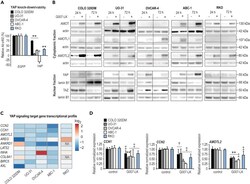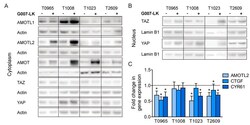Antibody data
- Antibody Data
- Antigen structure
- References [3]
- Comments [0]
- Validations
- Other assay [2]
Submit
Validation data
Reference
Comment
Report error
- Product number
- PA5-42267 - Provider product page

- Provider
- Invitrogen Antibodies
- Product name
- AMOTL1 Polyclonal Antibody
- Antibody type
- Polyclonal
- Antigen
- Synthetic peptide
- Description
- Peptide sequence: LTQEDPQMVY QSARQEPQGQ EHQVDNTVME KQVRSTQPQQ NNEELPTYEE Sequence homology: Cow: 93%; Dog: 79%; Guinea Pig: 100%; Human: 100%; Mouse: 100%; Rabbit: 100%
- Reactivity
- Human
- Host
- Rabbit
- Isotype
- IgG
- Vial size
- 100 μL
- Concentration
- 0.5 mg/mL
- Storage
- -20°C, Avoid Freeze/Thaw Cycles
Submitted references Identification of response signatures for tankyrase inhibitor treatment in tumor cell lines.
A Small-Molecule Tankyrase Inhibitor Reduces Glioma Stem Cell Proliferation and Sphere Formation.
Tankyrase inhibition sensitizes melanoma to PD-1 immune checkpoint blockade in syngeneic mouse models.
Mygland L, Brinch SA, Strand MF, Olsen PA, Aizenshtadt A, Lund K, Solberg NT, Lycke M, Thorvaldsen TE, Espada S, Misaghian D, Page CM, Agafonov O, Nygård S, Chi NW, Lin E, Tan J, Yu Y, Costa M, Krauss S, Waaler J
iScience 2021 Jul 23;24(7):102807
iScience 2021 Jul 23;24(7):102807
A Small-Molecule Tankyrase Inhibitor Reduces Glioma Stem Cell Proliferation and Sphere Formation.
Kierulf-Vieira KS, Sandberg CJ, Waaler J, Lund K, Skaga E, Saberniak BM, Panagopoulos I, Brandal P, Krauss S, Langmoen IA, Vik-Mo EO
Cancers 2020 Jun 19;12(6)
Cancers 2020 Jun 19;12(6)
Tankyrase inhibition sensitizes melanoma to PD-1 immune checkpoint blockade in syngeneic mouse models.
Waaler J, Mygland L, Tveita A, Strand MF, Solberg NT, Olsen PA, Aizenshtadt A, Fauskanger M, Lund K, Brinch SA, Lycke M, Dybing E, Nygaard V, Bøe SL, Heintz KM, Hovig E, Hammarström C, Corthay A, Krauss S
Communications biology 2020 Apr 24;3(1):196
Communications biology 2020 Apr 24;3(1):196
No comments: Submit comment
Supportive validation
- Submitted by
- Invitrogen Antibodies (provider)
- Main image

- Experimental details
- Figure 5 G007-LK inhibits YAP signaling in the selected cell line panel and all cell lines depend on YAP for sustained proliferation (A) Endpoint MTS proliferation assay (Abs 492 ) 5-8 days after transfection with siRNA against YAP relative to control (100%, EGFP ) and experiment time 0 values (t 0 , 0%). Mean values +-SD for one representative experiment of minimum three repeated assays with six replicates each are shown. For A and D , two-tailed t-tests are indicated by ** (p < 0.01) and Mann-Whitney rank-sum tests are indicated by ++ (p < 0.01) and + (p < 0.05). (B) Immunoblots of cytoplasmic AMOT, AMOTL1, and AMOTL2 (upper panels) and nuclear YAP and TAZ (lower panels) after 24- or 72-h treatment with G007-LK (1 muM) compared to controls (0.01% DMSO). Actin and lamin B1 document protein loading and representative data from two or more independent experiments are shown. (C) YAP signaling target gene transcription (log 2 ) after 24-h treatment with G007-LK (1 muM) compared to controls (0.01% DMSO) (n = 2). NA = not available, no RNA detection. (D) Real-time RT-qPCR analyses of YAP signaling target genes, CCN1 , CCN2, and AMOTL2 , upon 24-h G007-LK treatment (1 muM) relative to control (0.01% DMSO). Mean values +-SD for combined data from a minimum of two independent experiments with three replicates each are shown. See also Figures 6 , S5 , and S6 .
- Submitted by
- Invitrogen Antibodies (provider)
- Main image

- Experimental details
- Figure 3 G007-LK stabilizes AMOT/AMOTL2 and reduces the expression of YAP/TAZ target genes. The effect of G007-LK treatment on the ( A ) cytoplasmic and ( B ) nuclear levels of YAP/TAZ signaling proteins; ( C ) Fold changes in gene expression of YAP/TAZ target genes, as assessed by qPCR upon treatment with G007-LK. For both analyses, GSC cultures were treated for 72 h with G007-LK (500 nM) or DMSO (0.01%). Values are relative to those of the DMSO control and are expressed as the fold changes from the DMSO control. The results are presented as the mean +- SD. * p < 0.05.
 Explore
Explore Validate
Validate Learn
Learn Western blot
Western blot Other assay
Other assay